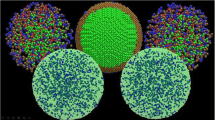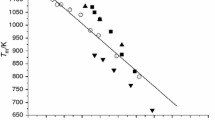Abstract
To elucidate the atomistic diffusion mechanism responsible for the rapid diffusion in alkali halide nano particles, called Spontaneous Mixing, we execute molecular dynamics simulations with empirical models for KCl-KBr, NaCl-NaBr, RbCl-RbBr and KBr-KI. We successfully reproduce essential features of the rapid diffusion phenomenon. It is numerically confirmed that the rate of the diffusion clearly depends on the size and temperature of the clusters, which is consistent with experiments. A quite conspicuous feature is that the surface melting and collective motions of ions are inhibited in alkali halide clusters. This result indicates that the Surface Peeling Mechanism, which is responsible for the spontaneous alloying of binary metals, does not play a dominant role for the spontaneous mixing in alkali halide nanoclusters. Detailed analysis of atomic motion inside the clusters reveals that the Vacancy Mechanism is the most important mechanism for the rapid diffusion in alkali halide clusters. This is also confirmed by evaluation of the vacancy formation energy: the formation energy notably decreases with the cluster size, which makes vacancy formation easier and diffusion more rapid in small alkali halide clusters.
Similar content being viewed by others
References
E.L. Wolf, Nanophysics and Nanotechnology (Wiley-VCH, 2008)
G.A. Ozin, A.C. Arsenault, L. Cademartiri, Nanochemistry: a chemical approach to nanomaterials (Royal Society of Chemistry, 2009)
M. Haruta, T. Kobayashi, H. Sano, N. Yamada, Chem. Lett. 16, 405 (1987)
M. Haruta, Nature 437, 1098 (2005)
H. Yasuda, H. Mori, Z. Phys. D 31, 131 (1994)
H. Yasuda, H. Mori, M. Komatsu, K. Takeda, H. Fujita, J. Electron Microsc. 41, 267 (1992)
H. Yasuda, H. Mori, Phys. Rev. Lett. 69, 3747 (1992)
Y. Kimura, Y. Saito, T. Nakada, C. Kaito, Phys. Low-Dim. Struct. 1/2, 1 (2000)
Y. Kimura, Y. Saito, T. Nakada, C. Kaito, Physica E 13, 11 (2002)
Y. Shimizu, S. Sawada, K.S. Ikeda, Eur. Phys. J. D 4, 365 (1998)
Y. Shimizu, K.S. Ikeda, S.I. Sawada, Phys. Rev. B 64, 075412 (2001)
R. Garrigos, P. Cheyssac, R. Kofman, Z. Phys. D 12, 497 (1989)
K.F. Peters, J.B. Cohen, Y.W. Chung, Phys. Rev. B 57, 13430 (1998)
T.R. Kobayashi, K.S. Ikeda, Y. Shimizu, S. Sawada, Phys. Rev. B 66, 245412 (2002)
T.R. Kobayashi, K.S. Ikeda, Y. Shimizu, S. Sawada, J. Chem. Phys. 118, 6552 (2003)
S.I. Sawada, Y. Shimizu, K.S. Ikeda, Phys. Rev. B 67, 024204 (2003)
F. Baletto, C. Mottet, R. Ferrando, Phys. Rev. Lett. 90, 135504 (2003)
M. Born, J.E. Mayer, Z. Phys. A 75, 1 (1932)
F.G. Fumi, M.P. Tosi, J. Phys. Chem. Solids 25, 31 (1964)
M.P. Tosi, F.G. Fumi, J. Phys. Chem. Solids 25, 45 (1964)
A. Aguado, J. Phys. Chem. B 105, 2761 (2001)
J. Jellinek, T.L. Beck, R.S. Berry, J. Chem. Phys. 84, 2783 (1986)
M.P. Allen, D.J. Tildesley, Computer Simulation of Liquids (Oxford University Press, 1989)
T. Niiyama, Y. Shimizu, T.R. Kobayashi, T. Okushima, K.S. Ikeda, Phys. Rev. E 79, 051101 (2009)
S. Sugano, Y. Nishina, S. Ohnishi, Microclusters (Springer, 1987)
P.G. Shewmon, Diffusion in Solids (McGraw-Hill, Inc., New York, 1963)
C. Kittel, Introduction to Solid State Physics, 8th edn. (Wiley, 2005)
R. Kofman, P. Cheyssac, R. Garrigos, Y. Lereah, G. Deutscher, Physica A 157, 630 (1989)
T. Zykova-Timan, D. Ceresoli, U. Tartaglino, E. Tosatti, Phys. Rev. Lett. 94, 176105 (2005)
S. Pehkonen, M. Ahtee, O. Inkinen, J. Phys. D 5, 767 (1972)
S. Pehkonen, J. Phys. D 6, 538 (1973)
N. Laurance, Phys. Rev. 120, 57 (1960)
H. Mizuno, M. Inoue, Phys. Rev. 120, 1226 (1960)
M. Sinder, D. Fuks, J. Pelleg, Phys. Rev. B 50, 2775 (1994)
W.H. Qi, M.P. Wang, Physica B 334, 432 (2003)
M. Müller, K. Albe, Acta Mater. 55, 3237 (2007)
T. Niiyama, S.I. Sawada, K.S. Ikeda, Y. Shimizu, Chem. Phys. Lett. 503, 252 (2011)
Author information
Authors and Affiliations
Corresponding author
Rights and permissions
About this article
Cite this article
Niiyama, T., Sawada, Si., Ikeda, K. et al. On the origin of atomistic mechanism of rapid diffusion in alkali halide nanoclusters. Eur. Phys. J. D 68, 78 (2014). https://doi.org/10.1140/epjd/e2014-40469-0
Received:
Revised:
Published:
DOI: https://doi.org/10.1140/epjd/e2014-40469-0




